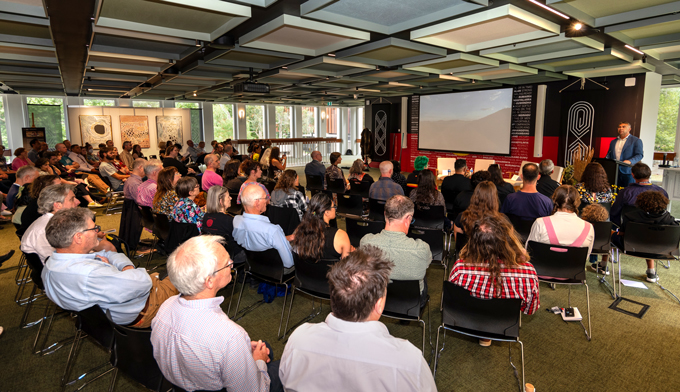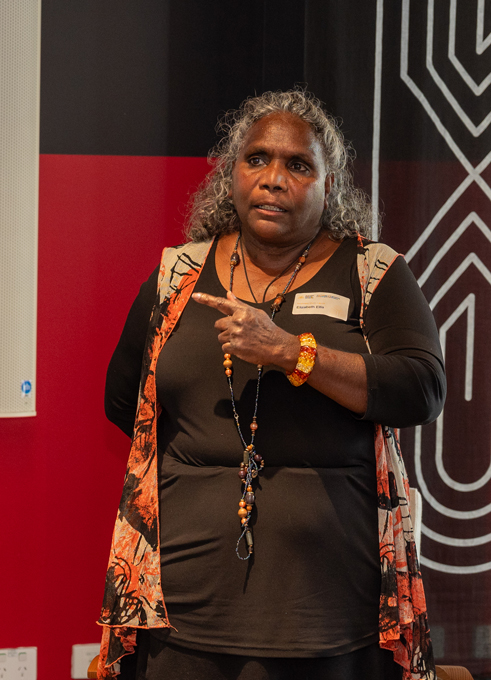Indigenous engineers, practitioners and researchers gathered with friends and allies at the Australian National University (ANU) on 23 November to celebrate the launch of the Bandalang Studio, the new Indigenous engineering design studio at The Australian National University.

Among the 140 persons who attended the launch event were the Bandalang residents doing research for this year’s program. Applications for the 2024 residencies opened last week.
“Think of an area of country that you’ve lived on long time. Think of how you relate to that country, and what you know about it,” said Dr Cat Kutay a 2023 Bandalang Resident from Yugambeh Country and a Lecturer in the Faculty of Science and Technology at Charles Darwin University.
“Imagine if that went 60, 80 thousand years back in your family. Imagine what you would know about that Country. That’s what we want to bring back to Australia.”
The Studio’s Indigenous-majority advisory board and world-leading academics at the ANU College of Engineering, Computing & Cybernetics (CECC) are mutually invested in bringing Indigenous perspectives into research and teaching, thereby augmenting transdisciplinary practices seen as essential for building resilient design systems.
Australia’s original systems engineers
2023 Resident Ella Noah Bancroft is a proud Bunjalung writer and environmental activist who said the residency has given her time to organise her thoughts in preparation for a research paper that will seek to bridge Indigenous knowledge with Western science with respect to the environmental engineering, specifically waterways and land use.
“There are tenants within Indigenous systems thinking, a mindset of collective care that informs all of our decisions,” Ms Bancroft said. “Not just care for Country, but for people, the ecology, custodianship and care and love as the highest values. That’s what we need to look to return to.”
Dr Kutay is developing Indigenous knowledge management through video, online, and mobile systems.
“Indigenous engineers aren’t bringing ideas that are unknown; they’re bringing ideas that have been forgotten,” Dr Kutay said. “Indigenous engineering didn’t change the landscape as much as we’re used to with Western engineering. Because it was minimal change, people think the work wasn’t done, but certainly it was done.
“A key message coming to us from Indigenous researchers and practitioners is that Indigenous knowledge systems is systems thinking and systems design,” said Nyssa Miller, Bandalang’s program manager. “We are well-placed at the School of Engineering to appreciate the power of this perspective, because our core focus in engineering is systems engineering.”
Ms Bancroft believes that pointing out the overlaps between Indigenous knowledge and Western science will help to overcome the colonialist mindset and other cultural barriers.
“We can shift not only our relationships but our planning around the natural world, utilising Western science to back up Indigenous wisdom so that we can formulate a new paradigm of existing with our waterways, beyond just seeing it as a resource,” she said.

Dr Elizabeth Ellis, a Bandalang resident from Ngaanyatjarra Country, spoke at the launch event.
“Our knowledge is in the land, so you need to support us to practice culture the way we need to, so that we can keep our important knowledge and care for our land and our peoples,” said Dr Ellis, whose research investigates Western Desert speech styles and verbal art.
“If institutions like ANU want to work with us then they need to make sure they are safe places for First Nations peoples to be. Bandalang Studio feels like a safe place for me to do this work. Every day I come to the studio to work, and I just love it.”
Machine that mimics human motion as old as time
2023 Bandalang residents Dan Ganter and Warren Saunders are brothers who have worked together as landscape engineers, botanists, horticulturalists and native plant experts.

“My work has been on regeneration seed, which is highly important for the regeneration of all types of land from mines to forestry and national parks,” said Mr Ganter who hails from Gungarri Country and works primarily on Yuin Country.
Mr Ganter said that native seeds require more time and careful handling because they are more delicate and complex than non-native grains.
“They’re hairy, they’re pointy,” he explained, which makes it more difficult to purify seed harvests that can contain dozens of species.
Mr Ganter is working with Western engineers at CECC to create seed-processing machinery as well as a viable economic model for harvesting and selling Indigenous seed.
“If we can’t find a machine to do it better than we do it by hand, then we’ll just keep doing it by hand. But we think we can develop modern machinery that can replicate that original human motion in a way that is scalable.”

Once the seeds are harvested, planting them presents challenges of its own.
“We’ve had to invent our own tools to work in Australian soil,” said Mr Saunders also from Gungarri Country and working on Ngunnawal and Ngambri Country.
“Overseas tools don’t work for us. We destroy them. So hard, tough tools based on Indigenous knowledge — Bandalang’s given me a chance to pull that knowledge together, not just from me, but from all those crews over the last 20 or 30 years working on landscape regeneration.”
Benefits of trandisciplinary ways of working
Ms Bancroft has been exploring methods and areas of focus for her research by meeting with experts at the Institute for Water Futures, the Fenner School, the School of Cybernetics, the School of Art and Design, as well as Dr Jeremy Smith from School of Engineering.

“The residency has given me this incredible space to think, to formulate my ideas, and come together with people who have really similar goals and interests,” Ms Bancroft said. “We have different ways of coming at it. But this is the beauty of collaboration, right? No one person is an expert. You become experts as a community together.”
“We’ve never felt so recognised and it’s giving us confidence as well,” said Mr Ganter. “The ANU has really put a lot of effort into Indigenous knowledge and art and industry, and they’ve got a real community here to help you to progress.”
Dr Kutay said she has been pleased to find that CECC engineers see the Bandalang residencies as an opportunity to enrich the teaching curriculum, as well as engineering practice in Australia and throughout the global scientific community.
“That’s why I like being on Ngunnawal and Ngambri Country, because this was a place where people did meet,” Dr Kutay said. “It was a parliament for Aboriginal people. And so it’s very symbolic that we now come back here as engineers and say, okay, we’ve now got to have parliament and discuss what are the important things for us in engineering.”
If you would like to see more of this kind of work, please consider supporting us through the School of Engineering General Fund.

